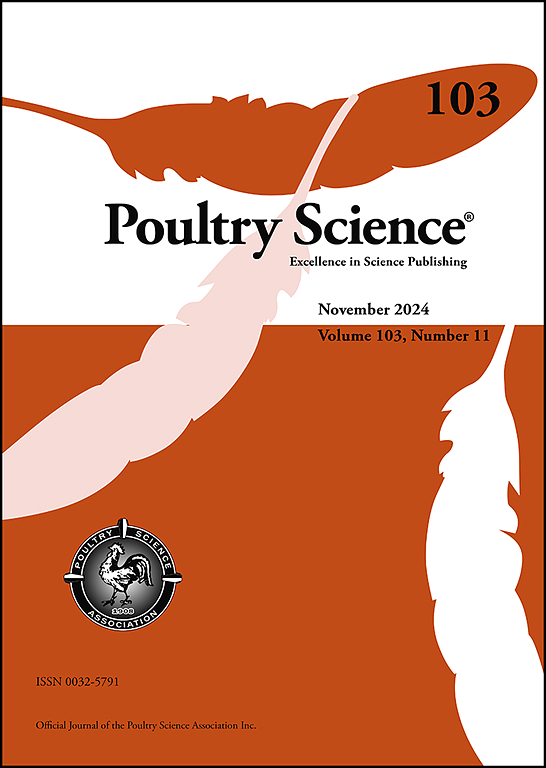Chlorogenic acid mitigates avian pathogenic Escherichia coli-induced intestinal barrier damage in broiler chickens via anti-inflammatory and antioxidant effects
IF 3.8
1区 农林科学
Q1 AGRICULTURE, DAIRY & ANIMAL SCIENCE
引用次数: 0
Abstract
This study was conducted to investigate the protective effects of chlorogenic acid (CGA) on intestinal health in broilers challenged with avian pathogenic Escherichia coli (APEC). One hundred and eighty one-day-old male broiler chicks were divided into three groups with six replicates of ten chicks each for a 21-day trial. The birds in the control and APEC groups were fed a basal diet, while birds in the CGA-treated group received a basal diet supplemented with 1000 mg/kg of CGA. At 14 days, birds in the APEC and CGA groups were administered with an APEC suspension Compared with the APEC group, CGA incorporation decreased mortality and cecal Escherichia coli colonies in bacterially challenged broilers (P < 0.05). Additionally, CGA reduced the relative weight of the heart, liver, kidney, gizzard, proventriculus, and intestine, as well as serum triglyceride level and alanine aminotransferase activity in APEC-challenged broilers (P < 0.05). Supplementing CGA reduced the concentrations of interferon-γ, tumor necrosis factor-α, interleukin-1β, and/or interleukin-6 in serum, duodenum, jejunum, and/or ileum in APEC-challenged broilers presumably through the inactivation of the toll-like receptor 4/myeloid differentiation factor 88 pathway (P < 0.05). CGA administration reduced serum diamine oxidase activity and d-lactate and endotoxin concentrations, but increased the ratio between villus height and crypt depth in duodenum and jejunum of APEC-infected chickens, accompanied by the restored intestinal expression of tight junction proteins (claudin-1, claudin-2, occludin, and zonula occludens-1) and genes involved in apoptosis (B cell lymphoma-2 associated X protein, B cell lymphoma-2, and cysteine-requiring aspartate protease 9) (P < 0.05). Additionally, CGA increased superoxide dismutase, glutathione peroxidase, and catalase activities, and glutathione levels in serum and intestinal mucosa, but inhibited the accumulation of intestinal malondialdehyde in APEC-challenged broilers possibly via activating the nuclear factor-erythroid 2-related factor-2/heme oxygenase-1 pathway (P < 0.05). The results suggested that CGA alleviated APEC-induced intestinal damage in broilers by inhibiting inflammation and oxidative stress. However, its potential application in practical poultry production is contingent upon both its efficacy and cost-effectiveness.
求助全文
约1分钟内获得全文
求助全文
来源期刊

Poultry Science
农林科学-奶制品与动物科学
CiteScore
7.60
自引率
15.90%
发文量
0
审稿时长
94 days
期刊介绍:
First self-published in 1921, Poultry Science is an internationally renowned monthly journal, known as the authoritative source for a broad range of poultry information and high-caliber research. The journal plays a pivotal role in the dissemination of preeminent poultry-related knowledge across all disciplines. As of January 2020, Poultry Science will become an Open Access journal with no subscription charges, meaning authors who publish here can make their research immediately, permanently, and freely accessible worldwide while retaining copyright to their work. Papers submitted for publication after October 1, 2019 will be published as Open Access papers.
An international journal, Poultry Science publishes original papers, research notes, symposium papers, and reviews of basic science as applied to poultry. This authoritative source of poultry information is consistently ranked by ISI Impact Factor as one of the top 10 agriculture, dairy and animal science journals to deliver high-caliber research. Currently it is the highest-ranked (by Impact Factor and Eigenfactor) journal dedicated to publishing poultry research. Subject areas include breeding, genetics, education, production, management, environment, health, behavior, welfare, immunology, molecular biology, metabolism, nutrition, physiology, reproduction, processing, and products.
 求助内容:
求助内容: 应助结果提醒方式:
应助结果提醒方式:


